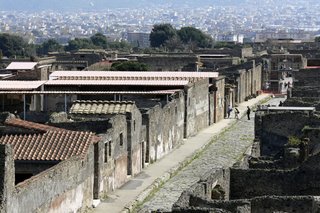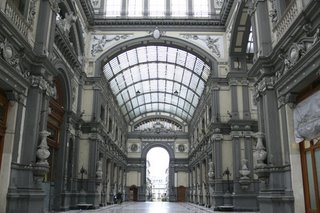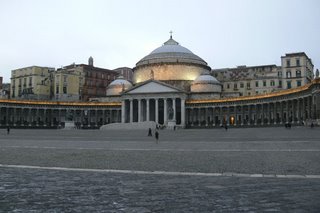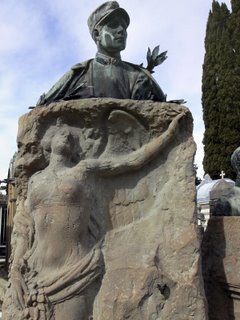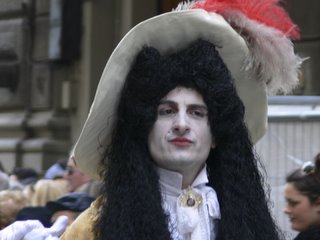
No really we did jet to Capri -- by jet boat!
Our good weather disappeared to be replaced by some pretty nasty weather and we awoke to a rainy, overcast and generally dreary Wednesday morning. Our original plan was to head out to Capri after breakfast and so we did. We walked the 10 minutes or so over to the ferry terminal (another good reason for staying in this part of Naples is the proximity to the ferry services) to catch the jet boat to Capri. We bought our tickets and waited a half hour or so until we boarded the ferry.
And what a great little ferry ride too – the boat had only indoor seating, with very comfortable chairs, all facing forward and we quickly picked a couple up toward the forward part of the boat. After about 40 minutes through pea soup and rain and some choppy water we landed on the isle of Capri (KAH-pree we are told is how they say it here) and were faced with the thought that we had six hours to kill before heading back. (Our return tickets specified a particular hour of departure although we wondered if we couldn’t have taken an earlier boat. particularly at this time of year. As you’ll soon see it wasn’t necessary.)
The little town of Capri – mostly residences and hotel and shops – sat on a bluff overlooking the harbor. (For those seeking a trip to the famed Blue Grotto they would catch one of the small boats right from the landing, and that boat would take you to the Blue Grotto and you would transfer to a much smaller boat, which would then row you into the grotto, or so we were told. Anyway word was there would be no visits to the Blue Grotto today due to rain and, more important, rough seas.)
Now normally there is a “funicolare” or cable car, which takes you right to the top from the harbor (Marina Grande) but it wasn’t running the day we were there and so there were large masses of people waiting in the rain for the alternative bus services, which were ferrying people up the hill. We decided to walk and so climbed our way up yet another sizeable hill, winding through tiny narrow alleyways where much work was being done in the middle of the path laying new pipe of some sort or another.
What astounds me is that we seem to be spending far more time walking uphill in Italy than down hill. It seems for every 10 steps I go up I go down two. I don’t get it.
So we eventually got to the top amidst the drizzle of a light rain and along with a small group of Italian students also on spring break and picked out a café where we could sit and have a cup of caffe and get out of the rain while we decided on what exactly we intended to do here.
After a short while the rain let up and we took out our map – we had stopped at the little tourist office by the ferry landing and picked one up for 80 cents – and figured we would head off to the south side of the island opposite from where we landed at Marina Grande to the vicinity of the Marina Piccola, or Small Marina, an easy walk. The woman we spoke with at the tourist office also suggested another itinerary as well which looked intriguing: walking along the bluffs overlooking the water on the south side of the island toward the natural arch. So we were off.
The town of Capri is pretty cool to be sure – although we could not imagine what it must be like in high season. These tiny, narrow streets packed with tourists and tour groups, with every shape and size of human being imaginable wandering aimlessly looking for gelato, lunch, a handbag or just a way to get away from everyone else made our blood run cold. We were glad to be doing this in late March although we still found ourselves inundated with numerous large groups of Italian students (all trying to look cool) and of course lots of folks who were also here because it is, well, spring break. And the tour groups from the Netherlands, America, Japan, wherever. Looking for what I have no idea.

Anyway, first we walked over to the Certosa (the Carthusian monastery which is undergoing serious renovation) and came across something I have never seen before in my life: Bird of Paradise growing wild, or rather growing in large bushes which I suppose were less than wild but still it was a first for me. Right away I knew this had been the right thing to do, coming to Kahpree. A few meters away from the Bird of Paradise we walked to some grand scenic overlooks where we couldn’t help but notice the tiny curving stone path, which wended its way down toward Marina Piccola. It was almost a work of art – sort of a work of art that made one queasy just looking at it,

From the Certosa and Bird of Paradise we set off to get away from the tour groups and headed toward the natural arch, and into the wilderness. From the Via Certosa you find your way to Via Tragara, which will eventually become Via Pezzolungo and will eventually lead you to the natural arch.
There were very few people out along this part of the island to be sure – we did meet up with three Italians part of the way and the five of us shared some small discoveries but we quickly found ourselves totally alone as we plunged deeper into the wilderness. (We assume the three Italians got home OK.)
The path although probably well maintained in high season, became increasingly covered with debris as if to remind us that the further we went the less attention this particular part of the trail received simply because it was away from any sort of ease of access. And of course much of the debris was from inattention during the winter as well.

The cliffs both above and below us were quite steep and there was much undergrowth. Still we were fortunate that it was not raining and at one point it even cleared enough so that we could see the tip of the Sorrento peninsula. Moreover, there were times when we caught a glimpse of the truly spectacular color of the water. In fact there were a couple of spectacular overlooks, which were a bit off the trail but which called to us nonetheless.
After about an hour or so of pretty level walking we started climbing up steps, about 5,000 steps or so it seemed to me. In fact we climbed for about another 15 or 20 minutes up some very steep steps –adding to the difficulty each riser was quite high from the next one and they had not been cleaned all season and were littered with detritus.
As we reached the top (thank the gods) we found ourselves at one of the coolest out-door bars you can imagine: with one of the outrageously beautiful views. They were doing some end-of-winter repair work and obviously getting ready for high season. We could just picture sitting out at one of the tables on a summer evening sipping wine and watching the world slip over the horizon. Wonderful!
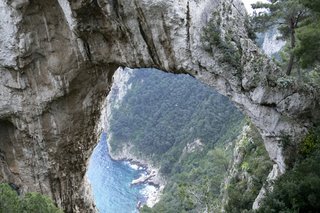
To the left at the top of the Steps from Hell would take us back to town in short order; to the right through the patio of the bar and another 300mts would take us to the natural arch but involved going down (and thus up) more stairs. We had come this far and so unlike the Russian family which had just gotten to the top of the Steps of the Cursed ahead of us and who chose to go back to town we headed off for the arch. Down we went and soon we were standing in front of, well, a big natural arch (what did you expect, that would find Jimmy Hoffa?) The arch was actually an old grotto, which had caved in – or so we were told.
After 60 seconds of appreciating this tiny little wonder we turned our back on it and climbed the steps – there were clearly more steps going up than down again proving my earlier point – and after a walk of another 15 minutes or so we were back in town.
It was mid-afternoon and we still had a couple of hours to kill before our boat so we thought we would find a reasonable place to eat in Capri (HAHAHAHAHAHAHAHAHAH!). Excuse me but I couldn’t help myself for a moment there.
Earlier we had spied a ristorante overlooking the harbor where we landed so we bought our bus tickets (to be used to take us back down to the harbor later) and then went to lunch.
We were nearly the only ones in the place – although toward the end of our meal a woman from Chicago and her friend from Lithuania came and sat down at the table next to us. When the sky cleared enough we could actually see the outline of Vesuvius at one point and the food was good I must admit although grossly overpriced. But then it is reasonable to assume that most everything on Capri is overpriced.
But at least our timing was impeccable. We had no sooner settled in and started sipping wine than a serious – and I mean serious -- rainstorm began and raged off and on for the next hour or so, even to the point of causing a bit of flooding in the ristorante. In fact, two women who were sitting at a table near us asked to be moved inside the ristorante proper because they were greatly disturbed by the noise and rain pelting their window (we were actually sitting in what was in fact the outdoor section although it was properly and securely battened down).
We finished our meal, had our dolci, caffe and a glass of red wine from Fruili-Venezia (red wine from Friuli of all places) which was very good indeed, compliments of the couple from Chicago-Lithuania, paid our bill and headed to the bus stop all of about 50 mts away. The rain had let up and we got to the landing in plenty of time to catch the boat back to Naples.
After we disembarked we stopped at a nearby newsstand to pick up a couple of cooking books Susan had her eye on for the past few days. One of the interesting things about newspapers and magazines in Italy is they will often bundle their publications with a DVD or music CD (usually classical) or a book or special publication.
For example, a recent issue of “Oggi” (“Today”) magazine carried with it the Michelin atlas for Italy. So for less than 10 euros you get the magazine and the road atlas (quite a savings actually).
Anyway, the newspaper “La Repubblica” has underwritten “L’Enciclopedia della Cucina Italiana” (the encyclopedia of the Italian Kitchen) and we happened to see an advertisement for the 13th volume in the series, “Small Pastries”. While we were waiting for the ferry to Capri I went into the newsstand to pickup a newspaper and saw the volume Susan was keen on getting so we planned to stop on the way back. She bought not only that one but also volume no. 11 on Torte (Cakes). I can’t wait for the homework.
Thursday morning the weather was overcast but no rain. After breakfast we packed, paid the hotel bill and walked over to the Piazza Trieste e Trento to catch the bus for Piazza Garibaldi and the train station. We got there in plenty of time to catch our 9:30 train for Florence. We were back in our apartment and unpacked by 1:30 that afternoon. Love that Eurostar.
Wish you were here,
Steve




